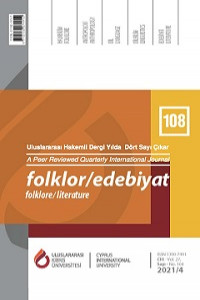Kütahya İli Altıntaş İlçesi Halk Mimarisinden Örnekler: Köy Odaları
Examples From The Public Architecture of Altıntaş District of Kütahya Province: Village Rooms
Author(s): Türkan AcarSubject(s): Museology & Heritage Studies, Customs / Folklore, Architecture, Islam studies, Rural and urban sociology
Published by: Uluslararası Kıbrıs Üniversitesi
Keywords: Kütahya; Altıntaş; rural settlement; folk architecture; village room;
Summary/Abstract: Village rooms are considered within the folk architecture in Anatolia. These rooms, which have an important place in village culture, are sometimes located near houses, sometimes in village squares and sometimes near mosques. Being one of the symbols of hospitality, the rooms are also one of the indispensable elements of social and cultural life in the countryside. The origin of the village rooms in Anatolia is based on the spatial characteristics of the core unit “room” in the Turkish House, which is based on the “dormitory type tent”. The Turks carried this tradition, which was continued in Central Asia, to Anatolia, and this tradition continued by taking into account the great care given to guests and hospitality along with the religion of Islam in verses and hadiths. Hosting guests by local residents and dignitaries has been considered as a religious service and social prestige, and it has become a competition to build rooms and entertain guests. In this study, it was determined that most of the village rooms identified in the villages of Altıntaş district were abandoned and dysfunctional. Village rooms, which symbolize hospitality, unity and solidarity, which started in Central Asia and moved to Anatolia, are the center of cultural and social life and are structures where intangible cultural heritage is embodied. The non-functioning of these structures today is a proof that we cannot claim this heritage.
Journal: Folklor/Edebiyat
- Issue Year: 27/2021
- Issue No: 108
- Page Range: 1013-1028
- Page Count: 16
- Language: Turkish

